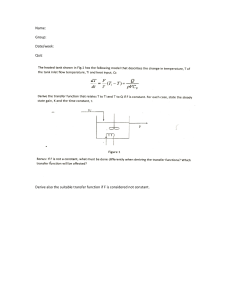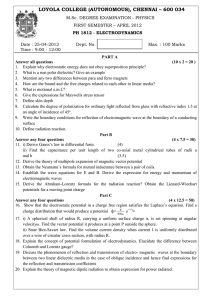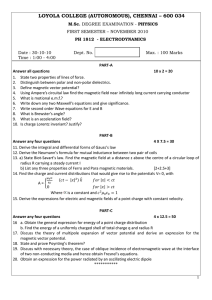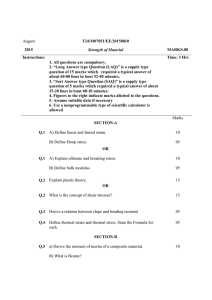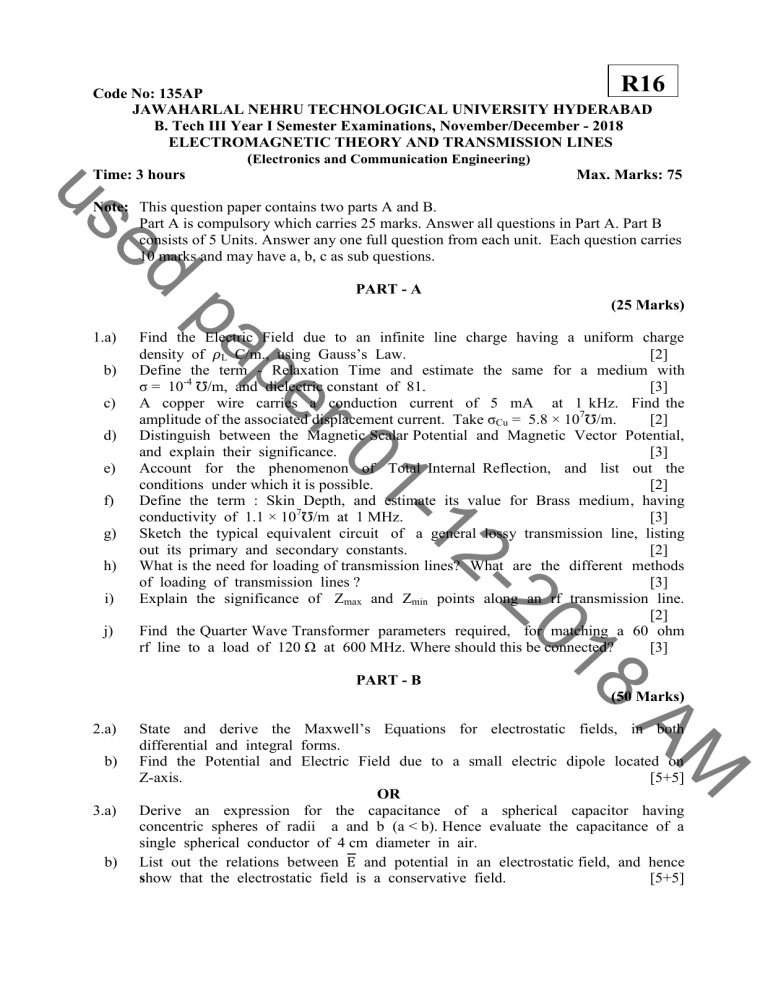
R16 Code No: 135AP JAWAHARLAL NEHRU TECHNOLOGICAL UNIVERSITY HYDERABAD B. Tech III Year I Semester Examinations, November/December - 2018 ELECTROMAGNETIC THEORY AND TRANSMISSION LINES (Electronics and Communication Engineering) Time: 3 hours Max. Marks: 75 us ed Note: This question paper contains two parts A and B. Part A is compulsory which carries 25 marks. Answer all questions in Part A. Part B consists of 5 Units. Answer any one full question from each unit. Each question carries 10 marks and may have a, b, c as sub questions. c) e) h) j) PART - B 8 01 -2 i) 12 g) 1- f) r0 d) Find the Electric Field due to an infinite line charge having a uniform charge density of 𝜌L C/m., using Gauss’s Law. [2] Define the term - Relaxation Time and estimate the same for a medium with σ = 10-4 Ʊ/m, and dielectric constant of 81. [3] A copper wire carries a conduction current of 5 mA at 1 kHz. Find the amplitude of the associated displacement current. Take σCu = 5.8 × 107Ʊ/m. [2] Distinguish between the Magnetic Scalar Potential and Magnetic Vector Potential, and explain their significance. [3] Account for the phenomenon of Total Internal Reflection, and list out the conditions under which it is possible. [2] Define the term : Skin Depth, and estimate its value for Brass medium, having conductivity of 1.1 × 107Ʊ/m at 1 MHz. [3] Sketch the typical equivalent circuit of a general lossy transmission line, listing out its primary and secondary constants. [2] What is the need for loading of transmission lines? What are the different methods of loading of transmission lines ? [3] Explain the significance of Zmax and Zmin points along an rf transmission line. [2] Find the Quarter Wave Transformer parameters required, for matching a 60 ohm rf line to a load of 120 Ω at 600 MHz. Where should this be connected? [3] pe b) (25 Marks) pa 1.a) PART - A (50 Marks) b) 3.a) b) State and derive the Maxwell’s Equations for electrostatic fields, in both differential and integral forms. Find the Potential and Electric Field due to a small electric dipole located on Z-axis. [5+5] OR Derive an expression for the capacitance of a spherical capacitor having concentric spheres of radii a and b (a < b). Hence evaluate the capacitance of a single spherical conductor of 4 cm diameter in air. List out the relations between E and potential in an electrostatic field, and hence show that the electrostatic field is a conservative field. [5+5] AM 2.a) 4.a) b) us 5.a) ed State Biot-Savart’s Law, and hence calculate the magnetic field due to a circular loop of radius R in z=0 plane, carrying a current I, at the points (0, 0, h) and origin. Derive the continuity equation for time varying fields, and hence establish Maxwell’s curl equation for time-varying magnetic field, explaining the concept of displacement current density. [5+5] OR State Ampere’s Circuital Law, and hence evaluate the magnetic field for a long cylindrical conductor of diameter 2a, carrying a dc current I, in the regions 𝜌 ≤ a, and 𝜌 ≥ a. State and derive the boundary conditions to be satisfied by the tangential components of electric and magnetic fields, at the surface of a perfect conductor. [5+5] b) 8.a) 9.a) b) Distinguish between the different types of distortions present in conventional transmission lines, and establish the condition for distortionlessness. A 75 ohm transmission line has a propagation constant of 0.05 + jper meter, at 50 MHz. Find its primary constants, assuming phase velocity as 60% of light velocity, and no distortion. [5+5] OR Explain the significance of infinite line, and hence obtain the general expression for the line characteristic impedance using the lossy line equivalent circuit. Establish the expressions for the propagation characteristics - α, β, γ, λ, υp , Zo, for lossy distortionless transmission lines. [5+5] 8 01 -2 b) 12 1- r0 7.a) b) pe b) Define and distinguish between ‘perpendicular’ and ‘parallel’ polarizations, when a UPW travelling in air, is obliquely incident on a perfect dielectric, with neat sketches. Also write the related boundary conditions for tangential components of electric fields in both cases. For a UPW with H = 0.4 cos(𝜔 t - 0.5 x) z A/m., find the dielectric constant, intrinsic impedance, direction of propagation and polarization, phase velocity and propagation constant, at 20 MHz. Also write the expression for E. [5+5] OR Show that a Uniform Plane Wave is a TEM Wave. A 100 MHz UPW is normally incident from air onto another perfect dielectric medium with = 2.25. Estimate the reflection and transmission coefficients for r E and H fields, deriving the expressions used. [5+5] pa 6.a) AM 10.a) Sketch the variations of input impedances of SC and OC lines with ℓ, and explain how a UHF line can be used as an inductance or a capacitance. b) A 50Ω rf line is connected to a load of 75 + j 40 ohms. Estimate the resultant reflection coefficient, VSWR, Zmin, Zmax. Also find its Input Impedance, if the line length is 0.5 λ. [5+5] OR 11.a) Explain the principle of impedance matching using a single stub tuner, and list out its limitations. b) Define the terms: Reflection Coefficient and VSWR and derive expressions for the same, as applicable to rf lines. [5+5] ---ooOoo---
